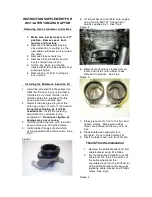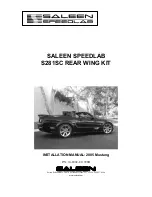
NOTE:
•
Do not attempt to make a shift while only the front or
rear wheels are spinning. The front and rear driveshaft
speeds must be equal for the shift to take place. Shift-
ing while only the front or rear wheels are spinning can
cause damage to the transfer case.
•
Delayed shifts out of four-wheel drive may be experi-
enced due to uneven tire wear, low or uneven tire
pressures, excessive vehicle loading, or cold
temperatures.
•
Shifting effort will increase with speed, this is
normal.
During cold weather, you may experience increased
effort in shifting until the transfer case fluid warms up.
This is normal.
4H TO 4L OR 4L TO 4H
With the vehicle rolling at 1 to 3 mph (2 to 5 km/h),
shift an automatic transmission into NEUTRAL (N), or
press the clutch pedal on a manual transmission. While
the vehicle is coasting at 1 to 3 mph (2 to 5 km/h), shift
the transfer case lever firmly to the desired position. Do
not pause with the transfer case in N (Neutral). Once
the shift is completed, place the automatic transmis-
sion into DRIVE or release the clutch pedal on a manual
transmission.
NOTE:
Shifting into or out of 4L is possible with the vehicle
completely stopped; however, difficulty may occur due
to the mating teeth not being properly aligned. Several
attempts may be required for clutch teeth alignment
and shift completion to occur. The preferred method is
with the vehicle rolling at 1 to 3 mph (2 to 5 km/h).
Avoid attempting to engage or disengage 4L with the
vehicle moving faster than 1 to 3 mph (2 to 5 km/h).
During cold weather, you may experience increased
effort in shifting until the transfer case fluid warms up.
This is normal.
WARNING!
Failure to engage a transfer case position completely
can cause transfer case damage or loss of power and
vehicle control. You could have a collision. Do not drive
the vehicle unless the transfer case is fully engaged.
FIVE-POSITION TRANSFER CASE —
IF EQUIPPED
The transfer case provides five mode positions:
•
2H — Two-Wheel Drive High Range
•
4H AUTO — Four-Wheel Drive Auto High Range
•
4H PART TIME — Four-Wheel Drive Part Time High
Range
•
N (Neutral)
•
4L — Four-Wheel Drive Low Range
For additional information on the appropriate use of
each transfer case mode position, see the following:
2H
Two-Wheel Drive High Range — This range is for normal
street and highway driving on dry, hard surfaced roads.
4H AUTO
Four-Wheel Drive Auto High Range — This range sends
power to the front wheels. The four-wheel drive system
will be automatically engaged when the vehicle senses
a loss of traction. Additional traction for varying road
conditions.
4H PART TIME
Four-Wheel Drive Part Time High Range — This range
maximizes torque to the front driveshaft, forcing the
front and rear wheels to rotate at the same speed. This
range provides additional traction for loose, slippery
road surfaces only.
N (Neutral)
WARNING!
You or others could be injured or killed if you leave the
vehicle unattended with the transfer case in the (N)
Neutral position without first fully engaging the parking
brake. The transfer case (N) Neutral position disen-
gages both the front and rear driveshafts from the pow-
ertrain, and will allow the vehicle to roll, even if the auto-
matic transmission is in PARK (or manual transmission
is in gear). The parking brake should always be applied
when the driver is not in the vehicle.
Neutral — This range disengages both the front and
rear driveshafts from the powertrain. To be used for flat
towing behind another vehicle
Four-Wheel Drive Gear Selector
156
STARTING AND OPERATING
5538906_24_JL_OM_EN_USC_t_E1.pdf 156
5/22/2023 9:02:23 AM
















































